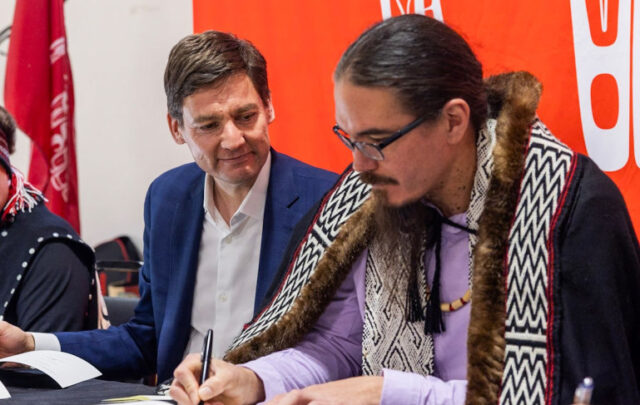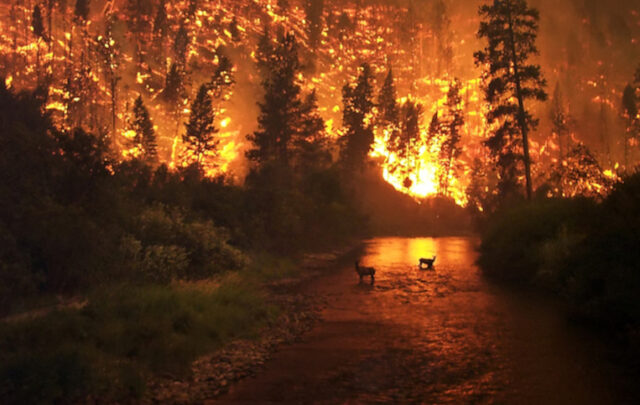I was browsing the Canadian Broadcasting Corporation (CBC) news website recently when the following item caught my eye.
It’s a good news story about how Canadian Natural Resources Limited (CNRL), Canada’s largest oil and gas producer, is hoping to reduce CO2 emissions from its tar sands operations to zero by using new technologies such as Carbon Capture and Storage (CCS) projects. The implication is that if we can deploy this technology on a large scale, business as usual can continue, because we can burn all the fossil fuels we want but leave the resulting CO2 in the ground. What’s not to like about that?
So what is CCS and how does it work? Here is a video by Shell explaining how it works.
In brief, CO2 is captured from the processing plant, pressurized to turn it into a liquid and transported by pipeline 65 kilometers to a number of well sites. The still-liquid CO2 is then injected more than two kilometres underground into a layer of rock filled with interconnected pores. The CO2 becomes trapped within the pores, and the layers of watertight rock above it stop it from escaping. Constant monitoring both above and below ground makes sure the CO2 stays safely and permanently in place. Get that – permanently. Forever. Over one million tonnes of CO2 are being captured and stored in this way each year, and four million tonnes have so far been captured and stored during the course of the project.
That’s the industry side of the story. But is it true? I have several concerns about it, including that little word “permanently”. I don’t see how you can inject highly pressurised, liquefied gas underground at a rate of one million tonnes per year and expect it to stay there “permanently”. The laws of physics and common sense suggest that it is going to find its way to the surface.
They say that a chain is only as strong as its weakest link. By the same token, an underground reservoir is only as gas tight as its leakiest part. And if you have a reservoir hundreds of kilometres wide, how many leaky parts are there going to be in that?
So I decided to investigate further. I contacted CNRL and asked for the pressure readings in the reservoir before, during and after the CO2 injection process. If the pressure in the reservoir failed to rise significantly while the gas was being injected, or rose during injection but then fell afterwards, either of those scenarios would suggest a leaky reservoir. It’s like pumping up a bicycle tyre: if you pump up the tyre but it rapidly goes flat again, you know there’s a hole in it.
The CCS facility appears to be a joint operation between Shell, CNRL and Chevron. I contacted Shell first. They suggested I contact CNRL. So I contacted CNRL. They suggested I contact Shell. This initial run-around did nothing to boost my confidence in the project. But eventually, after sending a third firmly-worded email, I got a response on behalf of Shell from Stephen Velthuizen, External Relations Manager for the Scotford Upgrader, of which the CCS project is a part. Essentially what he says in response to my questions about reservoir pressures is this:
- There is minimal pressure rise during the injection process, from a baseline pressure of 19.5 MPa (megapascals) to 20.5 MPa after injecting 4 million tonnes of CO2. These pressures are equivalent to 2,828 and 2,973 psi (pounds per square inch) respectively. For comparison, a bicycle tyre would typically be inflated to 50-130 psi.
- He wasn’t willing to give me any figures for how rapidly the pressure decays after the CO2 injection stops.
- In his own words: “But pressure alone – while an indicator – is not the only way to assess what is happening in a reservoir. One of the many technologies we use to monitor the CO2 is vertical seismic monitoring. By comparing a current vertical seismic profile (VSP) to our pre-injection VSP, we can detect the CO2 plume (through the variance). The VSP can also detect CO2 that has migrated out of the reservoir. The monitoring of many factors allows us to identify if a leak is occurring and take corrective action. We also have deep monitoring wells above the reservoir that provide valuable pressure information to indicate if a leak was present.”
I’d be very interested to hear from any readers who have expertise in geology or the operation of high pressure wells. I don’t – I’m just a simple family physician. But what Mr Velthuizen is saying sounds to me suspiciously like poppycock. I don’t believe a word of it. If you inject 4 million tonnes of gas into a reservoir, and there is hardly any rise in pressure, then surely common sense suggests that there is a leak: not just a small leak, but a massive leak, a leak so big that the gas is leaking out almost as fast as it can be pumped in? Like trying to pump up a flat bicycle tyre which obstinately remains flat? And all that talk about vertical seismic profiles and CO2 plumes sounds suspiciously like misdirection, which is what stage magicians do: they direct your attention to what they want you to see in order to direct your attention away from what they don’t want you to see.
Wishful thinking is a powerful emotion. That’s why the media and the public love a good news story like this and don’t ask too many questions. We really wish we had a magic wand to wave that pesky CO2 away so we can carry on flying our jets, driving our SUVs and eating food from the other side of the world with no consequences. We really wish that CCS would be that magic wand. The problem is that as far as I can tell, it probably doesn’t work.





